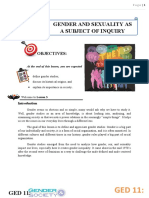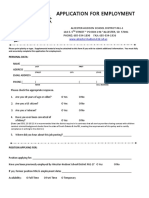0 ratings0% found this document useful (0 votes)
47 viewsTopic 3
The document discusses a lesson on gender and sexuality as a subject of inquiry, noting that gender studies aims to analyze how gender, sex, and sexuality impact our lives and create inequalities in society by examining power relations. It explores how gender roles have changed over time and are socially constructed rather than innate, and how gender studies questions traditional assumptions to promote diversity and inclusion.
Uploaded by
Dandrave LebigaCopyright
© © All Rights Reserved
Available Formats
Download as PPTX, PDF, TXT or read online on Scribd
0 ratings0% found this document useful (0 votes)
47 viewsTopic 3
The document discusses a lesson on gender and sexuality as a subject of inquiry, noting that gender studies aims to analyze how gender, sex, and sexuality impact our lives and create inequalities in society by examining power relations. It explores how gender roles have changed over time and are socially constructed rather than innate, and how gender studies questions traditional assumptions to promote diversity and inclusion.
Uploaded by
Dandrave LebigaCopyright
© © All Rights Reserved
Available Formats
Download as PPTX, PDF, TXT or read online on Scribd
You are on page 1/ 21
Lesson 3
GENDER AND SEXUALITY AS
A SUBJECT OF INQUIRY
Lesson Objectives
Students should be able to:
1. Define gender issues
2. Disscus its historical origins explain its
important in society
3. Explain its important in society
Gender seems so obvious and so simple,
may would ask why we study it.
Well, gender studies as an area of
knowledge, is about looking into, analyzing,
and examining society so that we notice
power relations in the seemingly “simple
things”.
It helps us to see the issues in our everyday
lives through a different lens.
The goal of this lesson is to define and
appreciate gender issues.
Gender is a big part of our individuality and
society; it is a form of social organization.
Gender studies emerged from the need to
analyze how gender, sex and sexuality impact
our lives, especially how it creates gender
equality.
Acdg to Encyclopedia of Sex and Gender,
Gender role and sex role are “sets of
culturally defined behavior such as masculinity
and femininity”.
These roles are not fixed such that the
“culturally defines behavior” for men and
women may be very different 50 years ago or
vey different for people from other countries
or tribe.
The following are common statements we hear from people. Reflect
about your own thoughts. Do you agree or disagree with each
statement? Why or why not?
Statement Why you agree Why you disagree
Boys should not cry
Girls are bad drivers while
boys are superb drivers
Boys should not be allowed
to play dolls
Women should be prim and
proper. It is ok for men to be
rowdy, they are men anyway.
Gender studies is not just for women or all for
women, it is about everyone.
It explores how gender roles have changed
throughout our history and how it created
inequalities.
Our society has changed so much since then; the
jobs available for everyone is not so much
dependent on physical strength, making these jobs
accessible to women as well.
Most mothers also have a job now, so
they also provide for the family.
Gender studies would ask us to
question, is it still right to say that the
men are the providers of the family
when both mothers and fathers now
work and earn money.
DIVERSITY AND INCLUSION
Gender roles are socially constructed and are not
something that we are “born with”.
Society, through a lifelong process of
normalization, encourages or reprimands
behaviors to make a child adapt to these social
expectations.
A young boy is always encouraged to be brave, to
play rough, to be laoud, and to not show sign of
weaknesess such as crying.
A young girls is discouraged from playing rough
and being loud, instead they are told to be gentle
and soft.
If a child does not follow these gender roles, they
are reprimand by parents, relatives, friends or
anybody that they interact with. This is how gender
norm is forced upon an individual, a lifelong
process of normalization.
Lesbian, gay, bi, and transgender people often do
not fit in the traditionally gender roles so they are
often reprimand, bullied, and descriminated. They
are often subjected to violence and hate just
because they do not fit in what society calls
“normal”.
Let us analyze the creation and maintenance of these
gender norms so that it does not created inequalities in
our socia, poltical and economic spheres.
Would you be willing to be Befriend somoene who....
Is a native of a different country?
Does not have the same religious
beliefs as you do?
Has a physical or mental disability?
Does not speak your language?
Gender Studies and Research
As a subject of inquiry, gender studies utilizes a
systematic approach in identifying problems,
making hypotheses and assumptions, gathering
data, and making conclusion.
This systematic process is reffered to as the
research process.
Approach in Research
Qualitative approach focuses more on the
meaning created and interpretation made by
people about their own personal or observed
experiences.
Example, if you want to know women, men or
LGBTQ+ live their on a daily basis and how they
make sense of their lived experiences, then this
approach is fitting.
Quantitative approach focuses more on
characteristics a population (total number of
individual in a group) or a sample (a sub-group
within the population).
Information from both approached provide
holistic view on social realities to derive data from
multiple response.
Ethics in Gender and Sexuality Research
1. Informed Consent – Researchers should make
sure that the participant in the study are aware of
the purpose of the study they are participating in.
They should also ensure only those participants who
agree (in writing) will be included, and that they
shall not force any participant to join.
2. Confidentiality and anonymity – Researhcers should
not reveal any information provided by the participants,
much so, their identity to anyone who are not
concerned with the study. All data gathered from the
survey or interviews should also be palced in a secure
location or filing system.
3. Non maleficence and benefecience – A study do no
harm (non-maleficence) to anyone. Especially in
research involving humans, a study in researchers
involving humans, a study should be benefecial for it to
be worth implementing.
4. Distributive justice – Any study should not
disadvantage a particular group, especially the
marginalized and the oppressed (eg., poor people,
women, LGBTQ+, the elderly) The benefits of a study
should be for all.
Lets do Research
“The Effect of Descrimination to LGBT
Community in Sultan Kudarat”
Objectives of the Study
1. To determine the socio-demographic profile of the informants.
1.1 Age
1.2 Educational Attainment
1.3 Gender Orientation
1.4 Religion
2. To determine who are mostly descriminated.
3. To determine the reason why the LGBT community are being descriminated.
4. To assess the level of descrimination in terms of:
4.1 work
4.2 school
4.3 religion
4.4 family
5. To determine the effects of descrimination to the LGBT community in
5.1 psychological
5.2 Social
5.3 political
Instruction.
1. Print all the responses of the informant.
2. Made a conclusion and recommendation.
3. Have a documentation. (pictorials)
Content of research
Introduction
Findings
Conclusions
Recommendations
Documentations
You might also like
- Lesson 3-Gender and Sexuality As A Subject of Inquiry100% (3)Lesson 3-Gender and Sexuality As A Subject of Inquiry20 pages
- Good Sexual Citizenship: How to Create a (Sexually) Safer WorldFrom EverandGood Sexual Citizenship: How to Create a (Sexually) Safer WorldNo ratings yet
- The Search for Why: A Revolutionary New Model for Understanding Others, Improving Communication, and Healing DivisionFrom EverandThe Search for Why: A Revolutionary New Model for Understanding Others, Improving Communication, and Healing DivisionNo ratings yet
- Lesson 3 Gender and Sexuality As A Subject of Inquiry 3No ratings yetLesson 3 Gender and Sexuality As A Subject of Inquiry 320 pages
- Gender and Sexuality As A Subject of InquiryNo ratings yetGender and Sexuality As A Subject of Inquiry23 pages
- Gender and Sexuality As A Subject of InquiryNo ratings yetGender and Sexuality As A Subject of Inquiry14 pages
- Lesson 3 - Gender and Sexuality As A Subject of InquiryNo ratings yetLesson 3 - Gender and Sexuality As A Subject of Inquiry18 pages
- Gender and Sexuality As A Subject of InquiryNo ratings yetGender and Sexuality As A Subject of Inquiry10 pages
- Gender and Sexuality As A Subject of Inquiry100% (7)Gender and Sexuality As A Subject of Inquiry14 pages
- GENDER-AND-SEXUALITY-AS-A-SUBJECT-OF-INQUIRYNo ratings yetGENDER-AND-SEXUALITY-AS-A-SUBJECT-OF-INQUIRY24 pages
- Page - 1 Gender and Society Instructional MaterialNo ratings yetPage - 1 Gender and Society Instructional Material5 pages
- Lesson 3 Gender and Sexuality As A Subject of InquiryNo ratings yetLesson 3 Gender and Sexuality As A Subject of Inquiry4 pages
- Lesson-3-Gender-and-Sexuality-as-as-Subject-of-InquiryNo ratings yetLesson-3-Gender-and-Sexuality-as-as-Subject-of-Inquiry18 pages
- Gender and Sexuality As A Subject of InquiryNo ratings yetGender and Sexuality As A Subject of Inquiry15 pages
- Lesson 3 Gender and Sexuality As A Subject of InquiryNo ratings yetLesson 3 Gender and Sexuality As A Subject of Inquiry5 pages
- Brown and Black Aesthetic Portofolio Presentation_20250211_145041_0000No ratings yetBrown and Black Aesthetic Portofolio Presentation_20250211_145041_000016 pages
- Lesson 3:: Gender and Sexuality As A Subject or Inquiry100% (2)Lesson 3:: Gender and Sexuality As A Subject or Inquiry11 pages
- Gender and Sexuality As A Subject of InquiryNo ratings yetGender and Sexuality As A Subject of Inquiry8 pages
- Gender-and-Sexuality-as-a-Subject-of-InquiryNo ratings yetGender-and-Sexuality-as-a-Subject-of-Inquiry3 pages
- Lesson 2 Gender and Sexuality as a Subject of InquiryNo ratings yetLesson 2 Gender and Sexuality as a Subject of Inquiry33 pages
- Gale Researcher Guide for: Overview of Gender and Sexuality in PsychologyFrom EverandGale Researcher Guide for: Overview of Gender and Sexuality in PsychologyNo ratings yet
- Chapter 1 Understanding Gender and Sexuality As A Social RealityNo ratings yetChapter 1 Understanding Gender and Sexuality As A Social Reality31 pages
- Gender and Sexuality As A Subject of Inquiry 3: Objectives100% (1)Gender and Sexuality As A Subject of Inquiry 3: Objectives8 pages
- Lesson 3 - Gender and Sexuality As A Subject of InquiryNo ratings yetLesson 3 - Gender and Sexuality As A Subject of Inquiry25 pages
- Gender and Sexuality As A Subject of InquiryNo ratings yetGender and Sexuality As A Subject of Inquiry15 pages
- Gender and Sexuality As A Subject of InquiryNo ratings yetGender and Sexuality As A Subject of Inquiry8 pages
- Ge-El1 - U1l3 - Gender and Sexuality As A Subject of InquiryNo ratings yetGe-El1 - U1l3 - Gender and Sexuality As A Subject of Inquiry29 pages
- A Joosr Guide to... Delusions of Gender by Cordelia Fine: The Real Science Behind Sex DifferencesFrom EverandA Joosr Guide to... Delusions of Gender by Cordelia Fine: The Real Science Behind Sex DifferencesNo ratings yet
- Chapter1 UNDERSTANDING GENDER AND SEXUALITY AS A SOCIAL REALITYNo ratings yetChapter1 UNDERSTANDING GENDER AND SEXUALITY AS A SOCIAL REALITY31 pages
- A Guy’s Guide to Sexuality and Sexual Identity in the 21st CenturyFrom EverandA Guy’s Guide to Sexuality and Sexual Identity in the 21st CenturyNo ratings yet
- Radical Inclusion: Embracing Diversity And Building Inclusive CommunitiesFrom EverandRadical Inclusion: Embracing Diversity And Building Inclusive CommunitiesNo ratings yet
- Bodies, Boundaries & Delight: A 3-Step Empowerment System for Parents and Professionals of Children aged 0-5From EverandBodies, Boundaries & Delight: A 3-Step Empowerment System for Parents and Professionals of Children aged 0-5No ratings yet
- GNED 10A Gender and Sexuality As A Subject of InquiryNo ratings yetGNED 10A Gender and Sexuality As A Subject of Inquiry11 pages
- Social Spaces for Older Queer Adults: A Guide for Social Work Educators, Students, and PractitionersFrom EverandSocial Spaces for Older Queer Adults: A Guide for Social Work Educators, Students, and PractitionersNo ratings yet
- Sexual Integrity in the 21St Century?: Exploring Chastity. for Individuals and GuardiansFrom EverandSexual Integrity in the 21St Century?: Exploring Chastity. for Individuals and GuardiansNo ratings yet
- MODULE 1 (Lesson 2-3) in Gender and Society: Fiona Yvannie T. Murillo BSSW As 3-1100% (2)MODULE 1 (Lesson 2-3) in Gender and Society: Fiona Yvannie T. Murillo BSSW As 3-16 pages
- Lesson 2: Gender and Sexuality Across Time Motivation: Activity 1No ratings yetLesson 2: Gender and Sexuality Across Time Motivation: Activity 16 pages
- Lesson 2: Gender and Sexuality Across Time Motivation:: Activity 1No ratings yetLesson 2: Gender and Sexuality Across Time Motivation:: Activity 14 pages
- Cracking the Female Code: Discover the Hidden Science of Attraction, Gain an Edge in Relationships with WomenFrom EverandCracking the Female Code: Discover the Hidden Science of Attraction, Gain an Edge in Relationships with WomenNo ratings yet
- Original S.T.A.R.S. Guidebook for Older Teens and Adults: Original S.T.A.R.S. Guidebook for Older Teens and AdultsFrom EverandOriginal S.T.A.R.S. Guidebook for Older Teens and Adults: Original S.T.A.R.S. Guidebook for Older Teens and AdultsNo ratings yet
- Equity Outside the Box: A Framework for Engaging Diverse LearnersFrom EverandEquity Outside the Box: A Framework for Engaging Diverse LearnersNo ratings yet
- A Field Guide to Gender-Neutral Language: For Business, Families & AlliesFrom EverandA Field Guide to Gender-Neutral Language: For Business, Families & AlliesNo ratings yet
- The Science of Social Intelligence: 45 Methods to Captivate People, Make a Powerful Impression, and Subconsciously Trigger Social Status and ValueFrom EverandThe Science of Social Intelligence: 45 Methods to Captivate People, Make a Powerful Impression, and Subconsciously Trigger Social Status and Value4.5/5 (4)
- AI and Recruiting Software Ethical and Legal ImplicationsNo ratings yetAI and Recruiting Software Ethical and Legal Implications18 pages
- Instant ebooks textbook Sociology Structure and Change 1st Edition Jodie M. Lawston download all chapters100% (1)Instant ebooks textbook Sociology Structure and Change 1st Edition Jodie M. Lawston download all chapters67 pages
- Extremism in The Ranks Stand-Down Training SlidesNo ratings yetExtremism in The Ranks Stand-Down Training Slides51 pages
- Understanding Race and Ethnic Relations 5th Edition Parrillo Test Bank Download100% (18)Understanding Race and Ethnic Relations 5th Edition Parrillo Test Bank Download9 pages
- United Nations - Commission On - The Status of WomenNo ratings yetUnited Nations - Commission On - The Status of Women24 pages
- Instant Download (Ebook) Professional Ethics and Human Values by D R Kiran ISBN 9789351342915, 9351342913 PDF All ChaptersNo ratings yetInstant Download (Ebook) Professional Ethics and Human Values by D R Kiran ISBN 9789351342915, 9351342913 PDF All Chapters81 pages
- Case - Study - Walking - in - Walk SolutionNo ratings yetCase - Study - Walking - in - Walk Solution3 pages
- Challenge of Living in A Diverse CommunityNo ratings yetChallenge of Living in A Diverse Community2 pages
- 272.international School v. Quisumbing - June 1, 2000No ratings yet272.international School v. Quisumbing - June 1, 20006 pages
- Sex Harassment, Discrimination Lawsuit Against New Castle CountyNo ratings yetSex Harassment, Discrimination Lawsuit Against New Castle County44 pages
- Are Articles 15 (4) and 16 (4) Fundamental Right?: by Mahenendra P. SinghNo ratings yetAre Articles 15 (4) and 16 (4) Fundamental Right?: by Mahenendra P. Singh12 pages
- Lesson 3-Gender and Sexuality As A Subject of InquiryLesson 3-Gender and Sexuality As A Subject of Inquiry
- Good Sexual Citizenship: How to Create a (Sexually) Safer WorldFrom EverandGood Sexual Citizenship: How to Create a (Sexually) Safer World
- The Search for Why: A Revolutionary New Model for Understanding Others, Improving Communication, and Healing DivisionFrom EverandThe Search for Why: A Revolutionary New Model for Understanding Others, Improving Communication, and Healing Division
- Lesson 3 Gender and Sexuality As A Subject of Inquiry 3Lesson 3 Gender and Sexuality As A Subject of Inquiry 3
- Lesson 3 - Gender and Sexuality As A Subject of InquiryLesson 3 - Gender and Sexuality As A Subject of Inquiry
- Page - 1 Gender and Society Instructional MaterialPage - 1 Gender and Society Instructional Material
- Lesson 3 Gender and Sexuality As A Subject of InquiryLesson 3 Gender and Sexuality As A Subject of Inquiry
- Lesson-3-Gender-and-Sexuality-as-as-Subject-of-InquiryLesson-3-Gender-and-Sexuality-as-as-Subject-of-Inquiry
- Lesson 3 Gender and Sexuality As A Subject of InquiryLesson 3 Gender and Sexuality As A Subject of Inquiry
- Brown and Black Aesthetic Portofolio Presentation_20250211_145041_0000Brown and Black Aesthetic Portofolio Presentation_20250211_145041_0000
- Lesson 3:: Gender and Sexuality As A Subject or InquiryLesson 3:: Gender and Sexuality As A Subject or Inquiry
- Lesson 2 Gender and Sexuality as a Subject of InquiryLesson 2 Gender and Sexuality as a Subject of Inquiry
- Gale Researcher Guide for: Overview of Gender and Sexuality in PsychologyFrom EverandGale Researcher Guide for: Overview of Gender and Sexuality in Psychology
- Chapter 1 Understanding Gender and Sexuality As A Social RealityChapter 1 Understanding Gender and Sexuality As A Social Reality
- Gender and Sexuality As A Subject of Inquiry 3: ObjectivesGender and Sexuality As A Subject of Inquiry 3: Objectives
- Lesson 3 - Gender and Sexuality As A Subject of InquiryLesson 3 - Gender and Sexuality As A Subject of Inquiry
- Ge-El1 - U1l3 - Gender and Sexuality As A Subject of InquiryGe-El1 - U1l3 - Gender and Sexuality As A Subject of Inquiry
- A Joosr Guide to... Delusions of Gender by Cordelia Fine: The Real Science Behind Sex DifferencesFrom EverandA Joosr Guide to... Delusions of Gender by Cordelia Fine: The Real Science Behind Sex Differences
- Chapter1 UNDERSTANDING GENDER AND SEXUALITY AS A SOCIAL REALITYChapter1 UNDERSTANDING GENDER AND SEXUALITY AS A SOCIAL REALITY
- A Guy’s Guide to Sexuality and Sexual Identity in the 21st CenturyFrom EverandA Guy’s Guide to Sexuality and Sexual Identity in the 21st Century
- Radical Inclusion: Embracing Diversity And Building Inclusive CommunitiesFrom EverandRadical Inclusion: Embracing Diversity And Building Inclusive Communities
- Bodies, Boundaries & Delight: A 3-Step Empowerment System for Parents and Professionals of Children aged 0-5From EverandBodies, Boundaries & Delight: A 3-Step Empowerment System for Parents and Professionals of Children aged 0-5
- GNED 10A Gender and Sexuality As A Subject of InquiryGNED 10A Gender and Sexuality As A Subject of Inquiry
- Social Spaces for Older Queer Adults: A Guide for Social Work Educators, Students, and PractitionersFrom EverandSocial Spaces for Older Queer Adults: A Guide for Social Work Educators, Students, and Practitioners
- Sexual Integrity in the 21St Century?: Exploring Chastity. for Individuals and GuardiansFrom EverandSexual Integrity in the 21St Century?: Exploring Chastity. for Individuals and Guardians
- MODULE 1 (Lesson 2-3) in Gender and Society: Fiona Yvannie T. Murillo BSSW As 3-1MODULE 1 (Lesson 2-3) in Gender and Society: Fiona Yvannie T. Murillo BSSW As 3-1
- Lesson 2: Gender and Sexuality Across Time Motivation: Activity 1Lesson 2: Gender and Sexuality Across Time Motivation: Activity 1
- Lesson 2: Gender and Sexuality Across Time Motivation:: Activity 1Lesson 2: Gender and Sexuality Across Time Motivation:: Activity 1
- Cracking the Female Code: Discover the Hidden Science of Attraction, Gain an Edge in Relationships with WomenFrom EverandCracking the Female Code: Discover the Hidden Science of Attraction, Gain an Edge in Relationships with Women
- Original S.T.A.R.S. Guidebook for Older Teens and Adults: Original S.T.A.R.S. Guidebook for Older Teens and AdultsFrom EverandOriginal S.T.A.R.S. Guidebook for Older Teens and Adults: Original S.T.A.R.S. Guidebook for Older Teens and Adults
- Equity Outside the Box: A Framework for Engaging Diverse LearnersFrom EverandEquity Outside the Box: A Framework for Engaging Diverse Learners
- A Field Guide to Gender-Neutral Language: For Business, Families & AlliesFrom EverandA Field Guide to Gender-Neutral Language: For Business, Families & Allies
- The Science of Social Intelligence: 45 Methods to Captivate People, Make a Powerful Impression, and Subconsciously Trigger Social Status and ValueFrom EverandThe Science of Social Intelligence: 45 Methods to Captivate People, Make a Powerful Impression, and Subconsciously Trigger Social Status and Value
- AI and Recruiting Software Ethical and Legal ImplicationsAI and Recruiting Software Ethical and Legal Implications
- Instant ebooks textbook Sociology Structure and Change 1st Edition Jodie M. Lawston download all chaptersInstant ebooks textbook Sociology Structure and Change 1st Edition Jodie M. Lawston download all chapters
- Understanding Race and Ethnic Relations 5th Edition Parrillo Test Bank DownloadUnderstanding Race and Ethnic Relations 5th Edition Parrillo Test Bank Download
- United Nations - Commission On - The Status of WomenUnited Nations - Commission On - The Status of Women
- Instant Download (Ebook) Professional Ethics and Human Values by D R Kiran ISBN 9789351342915, 9351342913 PDF All ChaptersInstant Download (Ebook) Professional Ethics and Human Values by D R Kiran ISBN 9789351342915, 9351342913 PDF All Chapters
- 272.international School v. Quisumbing - June 1, 2000272.international School v. Quisumbing - June 1, 2000
- Sex Harassment, Discrimination Lawsuit Against New Castle CountySex Harassment, Discrimination Lawsuit Against New Castle County
- Are Articles 15 (4) and 16 (4) Fundamental Right?: by Mahenendra P. SinghAre Articles 15 (4) and 16 (4) Fundamental Right?: by Mahenendra P. Singh

































































































